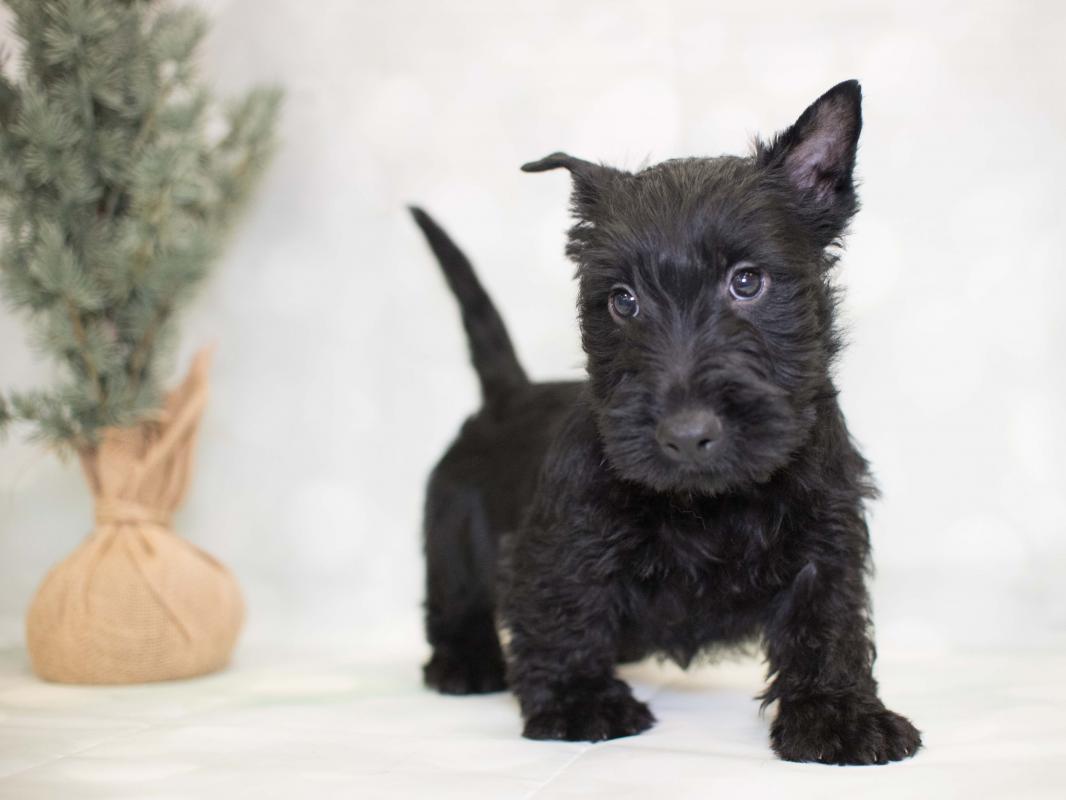Their unique looks and loving, protective personality make Scottish Terrier puppies the perfect choice
The Scottish Terrier is easily one of the most recognizable dog breeds in the world, with the familiar image of the wiry little pup appearing on everything from tote bags to Christmas ornaments. Despite their adorable looks and small size they are very dignified and serious dogs, known for their incredible loyalty to his family. In fact, they are wonderful with all family members, from children to the elderly. A much loved companion, the Scottie owns the distinction of being the only breed to have lived in the White House three times, with Presidents Franklin Roosevelt, Dwight Eisenhower and George W. Bush. Scottish Terriers measure up to 10 inches tall at the shoulder and weigh just 18 to 22 pounds, yet these little dogs are known to be great watchdogs, with a surprisingly loud bark. They have a double coat that can come in black, brindle, wheaten or sandy.
History
Although it is considered one of the oldest breeds, the origins of the Scottish Terrier can be difficult to trace. A description of a "small dog that would follow their quarry into the ground" in 55 B.C. is believed to be the first reference to a Scottie, who were indeed bred to be hunters and to follow vermin directly into their underground burrows.. By the early 1800’s, the Scottish Terrier was recognized as one of two distinct terrier breeds in Britain, along with the English Terrier. During the 19th century, Scottish Terriers were finally recognized as a breed of their own.
Temperament
The Scottie is an independent and dignified breed, yet they are known for being loving and devoted to their family. They’re extremely smart and can be aloof with strangers, which makes early socialization critical in order to avoid aggression as an adult. Despite their serious personality they can also be surprisingly sensitive to both praise and criticism so training should be done with a gentle approach. This breed gets along very well with older children but not so much with toddlers as they don’t appreciate having their tail or ears pulled.
Environment
Because of their small size, Scotties are adaptable to any living arrangements including apartments. However, they are known as alarm barkers, with a distinct, sharp bark rather than the lighter yap you’d expect from most small breeds, so you’ll need to work on training if you’re going to be living in close quarters. Also, even in smaller homes and apartments Scotties will need moderate exercise and mental stimulation daily in order to keep their energy in check.
Exercise
Bred as a hunter, the Scottie has not lost that instinct or the energy level that comes with it. This means they will need regular exercise in order to avoid destructive behavior. Their short legs make them less than ideal as a jogging companion but they love a good, brisk walk. It’s important to keep Scotties on a leash when walking because they will target small animals like squirrels and could chase them into the road. They are not swimmers so they don’t do well in homes with pools but their high energy and intelligence makes them ideal for agility training.
Grooming
The double coat of the Scottie requires a great deal of maintenance. The topcoat is hard and wiry and the undercoat is soft and dense. The hair grows continuously so there is not as much shedding as with short coated breeds but their skin will dry out quickly, which means you shouldn’t bathe them until absolutely necessary. The coat should be groomed weekly, more frequently for show dogs, and should be clipped every two months if you intend to keep their coat short. Periodic professional grooming is recommended. You should also trim their nails regularly and brush their teeth two or three times a week.
